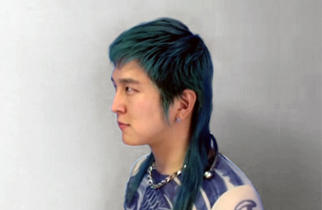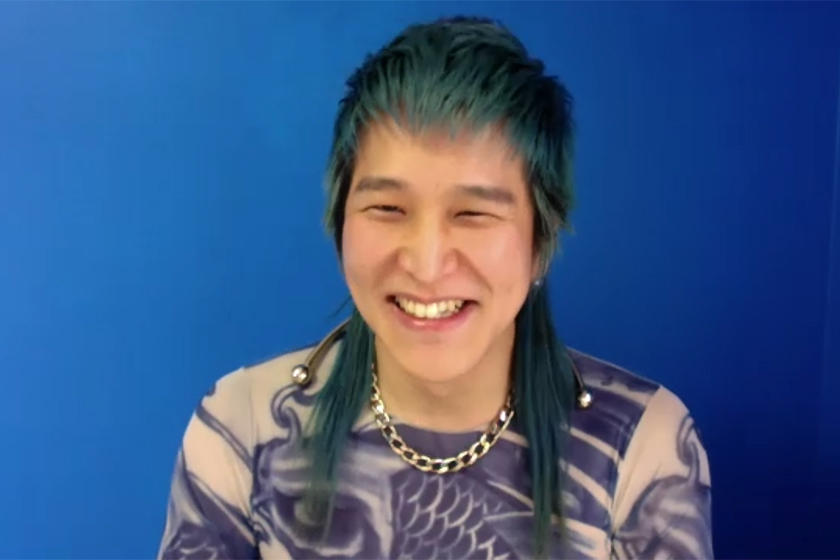

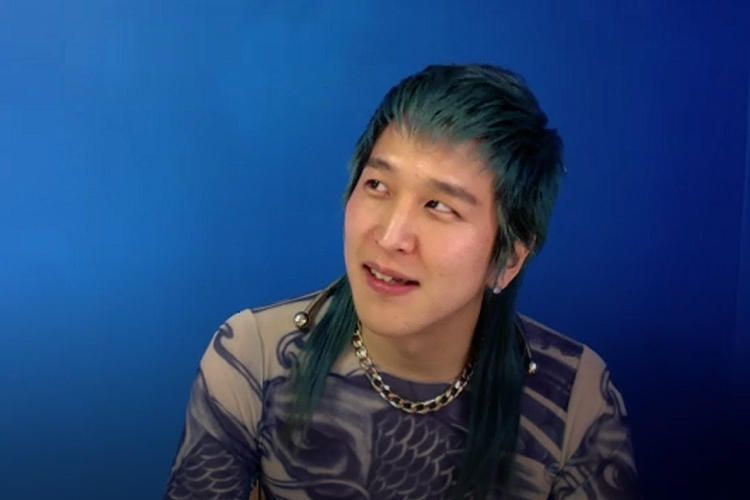
INTERVIEW
117
Dan IsomuraArtist
The art I can do now starts from the place I live
Designing while enjoying social connections
Dan Isomura creates numerous works focused on issues that strain modern society, such as those related to immigrants, refugees, religion, and gender and sexual minorities (GSM). Withdrawn as a child himself, and later aspiring to go to medical school, Dan did a 180-degree turn and instead taught himself about art and enrolled in Tama Art University. One year later, he took the exam to enter Tokyo University of the Arts and was unanimously accepted. He gets a lot of attention due to the major swings in his career; however, at the heart of his work lies the kindness of a person who has overcome many difficulties. How is a dramatically changing world seen through the eyes of a young, maverick artist? Due to the spread of the novel coronavirus, I conducted this interview online and asked Dan a lot of things, including questions about the half-year he recently spent in New York.
From New York to Tokyo, anxiety and the start of a new life
With assistance from the Asian Cultural Council, I stayed in New York for about six months starting in September of last year. I came back to Japan in early March. During my time in New York, people infected with the novel coronavirus were still primarily concentrated in Asia. As such, around January, when warnings about the virus were strengthening, it began feeling uncomfortable being Asian, even in New York. For example, you would be looked at suspiciously when riding the subway, and if you cleared your throat, strangers would complain vehemently. On the other hand, the number of people wearing masks in New York at that time was low, so when I saw an Asian person wearing a mask, I would unconsciously keep my distance. It was a time when many people, including myself, had trains of thought that were extreme.
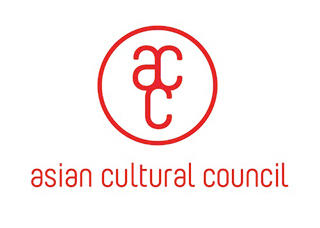
Asian Cultural Council
The Asian Cultural Council is a non-profit organization providing international cultural exchange opportunities to artists, researchers, and art professionals in Asia and the United States. Through a fellowship grant program for artists and art professionals in the visual and performing arts fields, international cultural exchange between the United States and Asia, and between Asian countries is supported.
About one week before I returned to Japan, the first person infected with the novel coronavirus in New York was confirmed. At that time, there were more infected people in Japan than in the US, so, with those close to me worrying about my wellbeing, I prepared to return home. However, within one week, the number of people infected with the virus shot up dramatically in New York; thus, I returned home confused about where a safe place would actually be. Upon arriving in Japan, I moved into a place in Shin-Okubo, and my first impression was that everyone seemed to be going about their lives in a surprisingly normal manner. In New York, a state of emergency had been declared, and there were serious additional measures announced, such as restrictions on going out. The difference between the two places was polarizing, and I started my life in Shin-Okubo in a state of anxiety. About two months have passed since then, but I still haven't completely finished moving. I am arranging my furniture and interior decorations, but I am still afraid of getting infected, so I have not gone to my parents' home to pick up belongings, and things from overseas have not yet arrived due to the impact of the virus.
The reason behind choosing Shin-Okubo, which is home to a lot of non-Japanese, as a base
I rented another space about 100sqm in size directly across from my new house. I am using it to start UGO, which will be a studio, gallery, and event space. I want to make it a place where various people, not just artists, can come and go freely. It is a place I will start with a few other artists, and it has been planned since before I went to New York. We planned to hold an opening party on March 21; however, we had to postpone that due to the coronavirus. Also, the original concept was to make it a place where large arbitrary groups of people could gather, but we are now in a situation where we have to rethink that from scratch as well.

UGO
A "new power spot" located a three-minute walk away from Shin-Okubo station and primarily managed by four artists: Dan Isomura, Keiichi Tatsumura, Chiho Hayashi, and Kensho Tambara. The plan is to operate the space as a production studio, event space, gallery, and bar etc.
I set up my new house and UGO in Shin-Okubo because it is one of Japan's foremost multicultural neighborhoods. My style of creating things while interacting with non-Japanese began when I was living in Uguisudani. There are a lot of things I cannot understand about people from other countries living in Japan unless I live nearby. I think it is better to have daily exchanges with non-Japanese people regularly rather than just timid and limited interaction. As you know, Shin-Okubo is a neighborhood that attracts a relatively large number of Koreans, Vietnamese, and Nepalese, as well as people from various other countries. As a volunteer, I used to teach Japanese to displaced persons, many of whom were from Africa. After class, they used to go to stores in Shin-Okubo to buy foods from their home countries that were hard to find in Japan. A staff member from a volunteer organization told me that they wanted me to teach a painting class, and I thought that I would like to have my own space and do that someday. For all these reasons, I chose Shin-Okubo, a neighborhood that people can easily visit even if they don't live there.
Using art to provide an objective point of view about problems that are difficult to put into words
I started to think about connecting social issues to my creations in 2013 when I was a student enrolled at the Tokyo University of the Arts. An international student from Germany who I had become friends with knew more about nuclear power plants in Japan than my Japanese classmates. When I asked him why he knew so much, he responded, "I was worried about living in Japan, so it is only natural to gather information. On the contrary, how come you don't know very much?" In Germany, everyday life, social issues, and art are intrinsically linked, and that international student themself created such works. Since then, I have become more self-aware of what I am usually thinking about and now create pieces while paying attention to social issues. At the same time, though there are many things I can do with painting, which I majored in at the Tokyo University of the Arts, incorporating ways of expression other than painting has become very natural for me, and that is where I am focused today.
Among the many social problems, issues related to immigrants and GSM were always in my head, but I felt these were topics that were difficult to talk about socially. Even now, when addressing the public, it is difficult to put my thoughts into words regarding these issues. I feel that by incorporating my message into my work, I can express myself more naturally and provide a more objective point of view than by simply speaking. I wanted to go to New York because these problems became apparent in society there early on, and they have been leading the world in addressing these issues while also experiencing a lot of backlash. I wanted to see the current situation with my own eyes, and I wanted to talk to people who had stories about the past. However, I was surprised to find that discrimination was still much more commonplace than I had imagined. It was disappointing at first, but it was also precisely because of that situation that many people were aware of discrimination as well. And it seemed that there was a shared consciousness of using reason to choose appropriate language and behavior.

An incident that revealed prejudices within me
While I was living in New York, there was a shocking incident that made me aware of discrimination. A woman was stabbed to death in a park that was about a ten-minute walk from my home. Of course, I had never been anywhere near the occurrence of a murder before, and it made me afraid to go out. The news reported that the suspected murderer was a 13-year-old boy. The neighborhood in which I lived, Harlem, has historically been home to many African Americans. When hearing that a 13-year-old boy had been involved in a stabbing around here, many people reflexively assumed that the suspect was African American. In fact, I encountered slips of the tongue and heard people saying, "the suspect was a young African American boy," at a stage when information regarding the race of the suspect had not yet been released. When I was living in Japan, I wanted to ensure I didn't harbor any feelings of discrimination or prejudice. I thought considerably about what to do to be sure that didn't happen. However, when exposed to a potentially life-threatening situation, I found myself wanting information, like that related to race, that could help me make a visual distinction. At first, my anxiety regarding my own personal safety was great and caused me a lot of stress. After a while, however, I became more and more stressed about noticing my own feelings of discrimination and wondering what to do about them.
During that time, I took a trip to Toronto, Canada. Compared to New York, I felt that the stereotypes there about race were relatively weak. I only stayed there a little under two weeks, so I don't know if my view accurately reflects reality, but I got the feeling the differences between the rich and poor were not divided by race. I realized that if stereotypes are not deeply rooted, it is difficult to harbor bias and discriminatory feelings. On the other hand, whether that is effective or not is a separate issue, but I found it was easier to have bias in places like New York. While feeling Toronto was a good city, I returned to New York and felt a sense of security in judging others as suspicious in the city's cold environment.
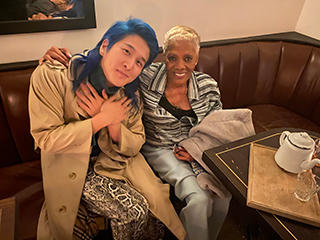
Staying in New York
Dan Insomura while staying in New York. In the picture he is having dinner with popular singer Dionne Warwick, who is also known as being Whitney Houston's cousin. She is also a strong rights advocate for the LGBTQ community in the United States.
It is impossible to know the background of other people you encounter when you go out on the street, and the information you garner on the spot ends up being, as expected, related to race. In New York today, a correlation can be seen between that bias and the crime rate. And I have to acknowledge that for self-protection, having some prejudice is better than having no information and will mean that you are less likely to be the victim of a crime. The problem, needless to say, is that the situations leading to that prejudice are not what the people of a particular race want to create but are what is created by society as a whole.
When I talked to an American friend about this, I learned that America is a place where race often tends to be a factor in economic and educational disparities. And now, the Black Lives Matter movement is gaining momentum, and I nodded in agreement when I read the words that this is "not a black vs. white" movement but an "everyone vs. discriminator" movement. If we don't think of it on the scale of "everyone (including those who have been complicit in discrimination to date) vs. a society that produces discrimination," I am afraid that it could newly push some people who couldn't help having some prejudice into the box of those advocating discrimination, thus further deepening the division. Of course, even in Japan, where there are a lot of subjectively racist people, I think the discussion that starts with "vs. people who discriminate" will similarly promote division and possibly create a place for extreme supporters of discrimination to fight back. It might sound like I am defending those who discriminate, so I would like to emphasize again that discriminatory behavior that can hurt or kill others should never be allowed, and I think we should take action to counter it.
The meaning of art that is not museum bound as its final destination
In Japan, I feel that the places where art and artists can fit in are limited. However, in New York, art is everywhere, and I got the impression that there is wide latitude for artists. Artists aiming to enter the market and have their collections exhibited at museums are probably commonplace; however, there are many art exhibitions in New York where that is not the aim. For example, there are small galleries at facilities that appear to have no relationship with art, such as a Human Rights Center for Immigrant Women. There are also people there who have curation-related jobs. Such places function as a tool for gaining wider acceptance for art. On the other hand, there are also relatively numerous opportunities to see the works of non-professional artists at museums and exhibitions and such, and they appear to be connected to each other in an uninterrupted manner.
An awareness that art is essential is stronger in New York than in Japan. Thus, people who do not intend to make their living from art or make it their primary business are also able to express themselves freely. I also feel that the people appreciating the art have the perspective that art isn't just about being expensive or being exhibited in a museum. I think the existence of such various places and of the art itself is very important.
A place where something can begin, even without having a great cause behind it
The opening of the space we launched, UGO, has been postponed, and we now have to rethink the concept. I am currently thinking about and troubling over what I can and should do as an artist. Initially, one of the things I wanted to do with this space was to lend it out to other artists and people who wanted to create works. It has been four years since I graduated from university; however, for people of my generation, or even for those older than me, it is financially and mentally difficult to continue working as an artist. There is a feeling that a future where the Japanese art scene becomes more prosperous and affluent is not capable of happening with the current environment. I also think the trend in Japan of "if you don't go to an art school you can't become an artist or be involved in arts" is causing the Japanese art scene to lose diversity. There are many people who want to express themselves even if they are not in the art community. Be they involved in art, or even those who are not, for example, among the refugees who I taught Japanese to as a volunteer, I believe there are those who want to express something. I wanted to create a bar counter in the space because I wanted to create a wide entryway for those who had no starting point for getting involved in art or the artist community, as well as to facilitate outside communication among the artists who tend to gather together in the existing community.
I would also like to hold various workshops with UGO serving as the base. I would like to use Shin-Okubo as the stage for collaborating with people from various cultural backgrounds. From workshops like straightforward painting classes to holding parties together, I would like to engage in a diverse range of activities. Regarding the problem of discrimination I touched upon earlier, I fear that those who advocate discrimination will have an excuse to discriminate. For example, if poverty becomes prevalent among a certain race living in Japan, the probability of them being alienated by society rises, and the crime rate among them will rise naturally as well. If that happens, we may face a quandary like that facing America. If we don't do what we can to avoid such a future right now, I have a sense of impending crisis that misunderstandings and prejudice will increase.
We cannot support such people financially, but we can build social connections. The current goal for the space may be to design a place where everyone can progress while having fun and making new discoveries, rather than a place where people move forward with a firm sense of duty. If we can do exhibitions together, the loose connections developed can spread, and the existence of various people will be visualized, which I think is good. The name of the space, UGO, is taken from the Japanese word Ugo-no-shu, which means mob or ragtag crowd. I want it to be a place where people with different social positions and roles gather, where mysterious encounters and disconcerted connections are born, a place where something can begin, and it doesn't necessarily have to be related to a great cause.
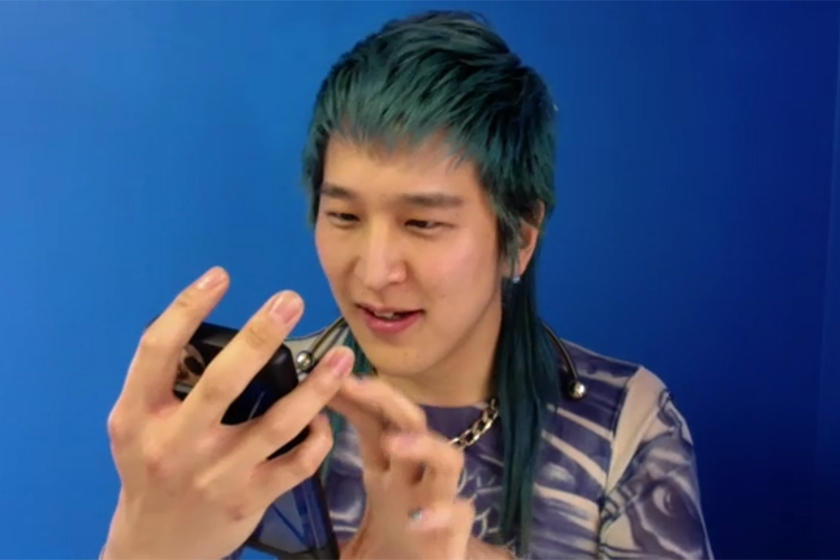
Dan Isomura participating in an online party just before the interview
Appreciating physical things and having actual experiences are what will become important
As the situation changes day by day, recently, what I have been thinking I can do is to ask the landlord to allow me to use the private road in front of UGO and have people gather there and do something instead of inside the facility. However, it is still difficult to get people to come from various places, so first of all, I would like to do something in a community-based manner for people who can access UGO on foot. For example, a blue-sky workshop for neighborhood children. Though I cannot say it unconditionally, I believe many of the non-Japanese living in Shin-Okubo have work that is unstable, and I think that children in such families often cannot go to school and are worried about being home alone. Another thing, though I think it may take some time to realize this, we are discussing the idea of using the large wall alongside the private road as a screen for an outdoor cinema.
Artists of my generation are holding exhibitions online or engaging in efforts to exhibit standalone works, and I am participating in some of these actions. However, I don't think online exhibitions can substitute for actually viewing a work in person.
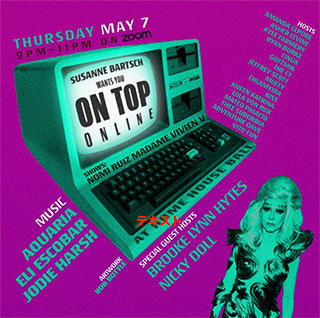
ON TOP ONLINE
An online party Dan participated in prior to the interview. The event was organized by Susanne Bartsch, also known as the face of New York nightlife. Participants unite to protest any form of discrimination, and safe places for people to express themselves are regularly provided. The latest event is being held online via Zoom.
Even if my works change, my way of living will not
As this feeling of being cooped up continues going forward, I think it makes for difficult living as people's thoughts are dominated by a range of information. However, I believe that art has the power to bring out things that are running on a different circuit from the thoughts that dominate everyday life. When it comes to my own expression and creations, I want to do what feels natural to me at the time, like switching over to my current style even though I majored in painting at university. From a market perspective, it is probably better to create a lot of similar works. However, as a contemporary artist, if things change, then things should be newly thought about and expressed as well. If I do that, then change will come naturally, even if that is not the intent. I think that coming to grips with change is something people need to do in the age of the coronavirus. On the other hand, as a person who wants to live while expressing himself, I have a feeling that my way of life will not change regardless of whether or not there is the coronavirus.
In the face of these current challenges, it can be considered a good opportunity for everyone to voluntarily think about various things. More people than ever are sharing their opinions about the government, and I feel that more and more people are starting to have an awareness that they are members of society. In thinking about what would be good for the future, it is almost kind of pointless to do it alone. I would like to think about that together with someone I meet, and I just hope that the immediate future does not go in some extreme direction. As such, it is important to never stop thinking. I think it would be good to have a future where we can share with more and more people, a sharing society.
Editor's thoughts
I was impressed with Dan's soft demeanor and careful choice of words during this online interview. And I think it was very courageous for him to acknowledge his own prejudices. Dan does not fail to notice the negative feelings he has within and confronts them in a comprehensive manner while asking himself why discrimination and bias still exist in society today. I would like to continue following his activities and see how he will channel his thinking process into his work going forward. As an aside, the bright blue wall he painted was wonderful! (text: ikuko hyodo)
Note: The image comprises screenshots taken during the online interview.
RANKING
ALL
CATEGORY




